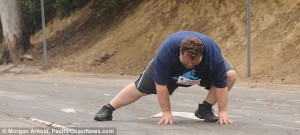
1. Myth: Crunches are the key to flat abs.

According to Jessica Matthews, spokesperson for the American Council on Exercise, crunches may be the best exercise around for abdominal fitness but it is not the best exercise to get flat abs.
“Since they don’t burn off a lot of calories, they don’t help in a major way with fat loss,” Wayne Westcott, PhD, professor ofexercise science at Quincy College in Quincy, Massachusetts said.
14 out of 15 students at Georgia State believed this was certainly a myth while one student believed it was a fact.
” I always thought it was a fact because that’s what I always saw on YouTube videos.” Diana Johnson, exercise science major student, said.
According to a study from Pennsylvania State University, crunches do tone a portion of your abs. “If you are doing crunches, make sure to use proper form; Otherwise, they may put your spine in a painful curved position.”
2. Myth: The more you sweat, the more you burn.
“Sweat is a biological response that cools your skin and regulates internal body temperature,” Matthews said.
She said more sweat does not mean that you burnt extra calories.
More students believed this myth was a fact. Only two students out of 15 believe this is a myth.
13 students said they believed it was fact because the more you sweat, the more calories you burn is what they always heard.
“If it’s not calories you burn when you sweat then what is it?” Sulman Mughal, a biology major, said.
A psychology student, Jamilah Dotson said, ” It is surprising to know this is a myth because I definitely thought the more you sweat the more calories you would burn.”
Matthews said sweat could be as a result of overheat, weather, or your personal physiology.
3. Myth: Running is bad for your knees
According to a Stanford University study, older runners’s knees were as healthy as those people who do not run.
Many students were undecided about this myth. Five students were sure that this is a myth. Four believed it is a fact. Six students said it depends on where you are running; track or treadmill.
“It depends on where you run. It can be bad if you run on treadmill,” Krupin Amin, CIS student said.
“When it comes to running, it can be perfectly fine for your knees unless you are running excessively, ” Jonelle Lafian, exercise science major student said.
Matthews suggests a full body strength work out at least twice a week, in addition to regular jogs because it helps strength muscles that support the knees.
4. Myth: Stretching helps your body recover faster.
A recent University of Milan study found no significant changes in blood lactate levels in people who stretch after exercise.
” Well I thought stretching does help. If you don’t stretch you prone to injury,” Patricia Motieram, respiratory therapy major, said.
” Your muscles don’t repair if you don’t stretch,” Assam Javed, biology major student said.
According to Westcott, the best way to increase joint flexibility is to stretch right after a workout “when the body is still warm.”
5. Myth: You need to sweat for 45 minutes to get a health benefit.
According to health.com, fact is that even if you spend 10 minutes, you have enough time to “bolster” your cardiovascular health. According to The New York Times, shorter work out sessions are often just as effective.
14 out of 15 students believed this was a myth.
6. Myth: More gym time is better.
According to a Los Angeles-based celebrity trainer Ashley Borden, rest day is crucial after a workout.
“If you work out every single day, you could injure yourself,” Bordon said.
Every student who was asked agreed with this myth.
“It’s not about the time in the gym, it’s about the intensity of the workout,” Varinder Singh, a finance student said.
An exercise major student Christian Dickers, who also works as a fitness attendee at Georgia State University said there should be more specific questions to determine whether a fitness belief is a myth or a fact.
“Like running is bad for your knees. It does not say where, for how long, and who is running.”
“Keep your workout varied! Doing the same training pattern can lead to injuries,” Valerie Waters, personal trainer to Jennifer Garner said.
Matthews said, “We have greater access to information, but it isn’t always accurate.”
